NEWS and RULES
This page introduces a range of related puzzles based on arrays of operators. Each operator enforces a simple, logical motion through an array cell, and onward into an adjacent cell. Each cell contains a maximum of one operator selected from a small, pre-defined set. The combined effect across the breadth of the array is often a complex interwoven network of pathways, ordered in one sense yet chaotic in another. Just the sort of behaviour that lends itself to some interesting puzzles and mazes.
Each sub-section below explores a different operator set and presents a range of puzzle variations:
NEWS maze
The NEWS maze is based on a grid of absolute directional operators (N/E/W/S), along with + that indicates a junction point, and blank that acts as a bridge. This combination of operators allows for some note-worthy mazes, here follows an example. Try far left to far right to begin with, and then try the reverse.
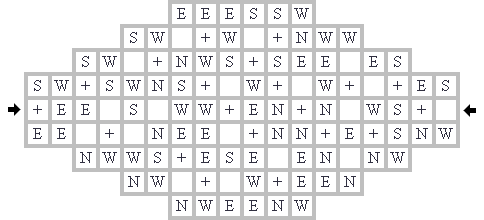
| Operators | |
|---|---|
| N | North only |
| E | East only |
| W | West only |
| S | South only |
| + | Everyway (NEWS) |
| blank | Straight only |
This maze has been carefully designed to offer two distinct yet equally difficult challenges, one in each direction. More often than not the reverse route will be either trivial or impossible, but this non-reversability (or implicit arrow) is a common feature of many puzzle-mazes, and certainly all puzzles on this page. Note that due to the absolute nature of the NEWS operators it would be quite possible to present NEWS using arrows instead of letters.
It is also worth noting that, without blank, NEWS would be significantly less complex since it would not be possible for paths to cross under and over each other. NEWS is the only operator set that relies entirely on blank for bridging but, that said, blank (or equivalent) will often still be present. A simple bridge is one of those fundamental maze building blocks that it is difficult to live without.
RULES maze
RULES is much like NEWS, but based on the set of relative rather than absolute operators. If you think about it R, U, L and S (relative) are the natural equivalents of N, E, W and S (absolute). The S (in RULES) however is also equivalent to blank (in NEWS) so we automatically drop the need for one operator. + is retained as a four-way junction point. Here is a small example:
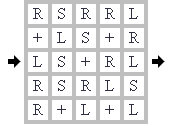
| Operators | |
|---|---|
| R | Right only |
| U | U-turn only |
| L | Left only |
| + | Everyway (RULS) |
| S | Straight only |
Note that in these mazes I make no attempt to eliminate the false exits around the perimeter of the grid, so it is quite possible to drop out of the maze at the wrong place. A dead-end of this sort is often called a black hole since the implicit arrow prevents you simply turning around and retracing your steps. With RULES, unlike NEWS, it seems a tad difficult to construct a maze with no false exits. A complete outer ring of L, R or U operators (with one S to allow entry/exit) would suffice, but is not particularly pleasing. I leave it as a challenge for the reader to construct a RULES maze (or simple RULS grid) with only one perimeter entry/exit point. Note that it is also possible to construct mazes with internal black holes (typically a loop with one or more entrance points, but no exit). The RULES mazes here have no internal black holes but the earlier NEWS maze did contain a small internal black hole, did you spot it?
Here is a slightly larger maze that illustrates RULES in full glory. In this maze you will have to visit some cells up to three times. The U operator is also used here, which is missing from the smaller example above.
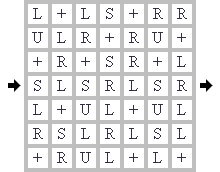
| Operators | |
|---|---|
| R | Right only |
| U | U-turn only |
| L | Left only |
| + | Everyway (RULS) |
| S | Straight only |
Multi-RULES maze
Multi-RULES is an extension of RULES that doubles up the meaning of each operator, turning each cell into a potential junction point (and dropping the need for +). The connectivity between cells gets a little unmanageable at this stage so U has been dropped completely (U-turns are never permitted) and blank (straight only) has been reinstated.
One of the aims of multi-RULES was to find an operator set that was 100% multi-state. NEWS is approx 20% multi-state and RULES 80% (by cell count) but significantly the decision points in both NEWS and RULES are always single-state. Multi-RULES, in contrast, is fully multi-state. This multi-RULES operator set is the smallest yet, but is also the most powerful. It turns out there is little need to use all the operators, all at the same time. Here is a maze based on just T and blank. It is a smaller example of my Left and right only maze (found in the gallery).
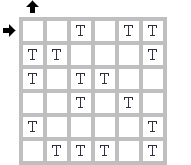
| Operators | |
|---|---|
| R | Right or straight |
| L | Left or straight |
| T | T-junction (left or right) |
| blank | Straight only |
And just to prove it is possible, here is a maze created entirely of R, L and T operators. If helpful, think of R as may go right and L as may go left. In this maze you always have two choices, so being forced out of the maze by accident is relatively easy to avoid, but beware, it can still happen. Oh, and beware of the central black hole.

| Operators | |
|---|---|
| R | Right or straight |
| L | Left or straight |
| T | T-junction (left or right) |
| blank | Straight only |
Colour-box puzzles
This puzzle returns to the traditional set of RULES operators but drops the + (junction) operator and thus moves away from the concept of a pure maze.
The best introduction to the colour-box puzzles is to try constructing your own. Take a 4 × 4 grid and fill it randomly with RULS operators, then trace through every possible pathway (sixteen in total). You will find that none of the paths converge, each exit point is used just once, and every cell is used exactly four times (unless you happen to have some internal black-holes). Most of the paths will be short but one or two will probably turn out extra long and twisty. Now, to create the puzzle simply take your RULS grid and redraw it using colours instead of letters. Finally mark in one or two entry/exit points, from your original sketch, and challenge someone to work out which colour maps to which operator.
Here is an example colour-box puzzle with a single, unique solution. This is the hardest of four puzzles that appeared on my Gathering For Gardner IV exchange handout.
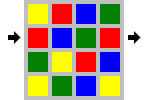
These puzzles are limited by the fact there are basically only 24 operator/key permutations to think about and process of elimination exhausts the options quite quickly. To increase the number of permutations (from 24 to 256) it was suggested I could simply drop the one-to-one relationship between operator and key. Some operators may be used more than once, some not at all. Here is one example of a 256-permutation colour-box puzzle. One trivial solution to this puzzle is red = yellow = blue = green = S, but can you find the one and only alternative solution?

Lattice puzzles
The lattice puzzles are a mind-boggling extension of the colour-box puzzles. Devised, developed and presented in native applet form by Graham. These puzzles will test your spatial awareness, as well as your powers of logical deduction. Graham replaced my 2D (4x4) grid with a 3D (3x3x3) lattice and selected seven of the available operators. Note that using three dimensions allows for a much broader range of operators; this increases the number of key/operator permutations and allows the one-to-one relationship to be retained.
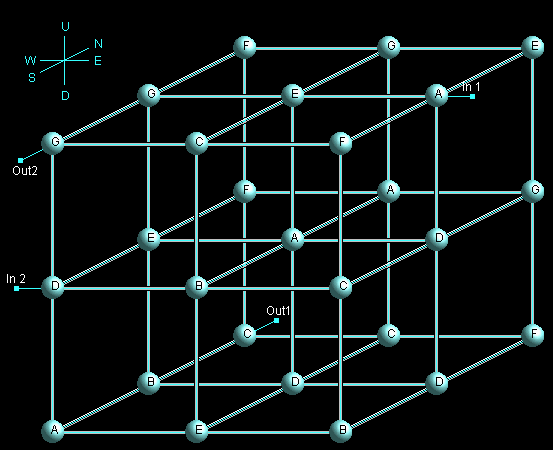
screen-shot of a 3x3x3 lattice-puzzle
| Operators | |
|---|---|
| Left | Left turn |
| Right | Right turn |
| Up | Nose up |
| Down | Nose down |
| Clock | Clockwise roll |
| Anti | Anticlockwise roll |
| Null | No turn or roll |
Note that Anti and Clock are roll operations that rotate you ninety degrees. They do not affect your direction only your orientation (Null affects neither direction nor orientation). I find it helpful to imagine myself in a fighter plane, or spaceship, flying through a network of tunnels. Click here to try the lattice puzzles (native java applet support required)
maze designs - © Andrea Gilbert 2000

